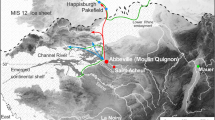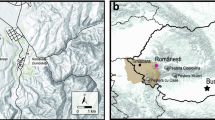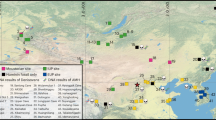Abstract
Luminescence dating at the stratified prehistoric site of Attirampakkam, India, has shown that processes signifying the end of the Acheulian culture and the emergence of a Middle Palaeolithic culture occurred at 385 ± 64 thousand years ago (ka), much earlier than conventionally presumed for South Asia1. The Middle Palaeolithic continued at Attirampakkam until 172 ± 41 ka. Chronologies of Middle Palaeolithic technologies in regions distant from Africa and Europe are crucial for testing theories about the origins and early evolution of these cultures, and for understanding their association with modern humans or archaic hominins, their links with preceding Acheulian cultures and the spread of Levallois lithic technologies2,3,4,5,6,7,8,9,10,11,12,13,14,15,16,17,18,19,20. The geographic location of India and its rich Middle Palaeolithic record are ideally suited to addressing these issues, but progress has been limited by the paucity of excavated sites and hominin fossils as well as by geochronological constraints1,8. At Attirampakkam, the gradual disuse of bifaces, the predominance of small tools, the appearance of distinctive and diverse Levallois flake and point strategies, and the blade component all highlight a notable shift away from the preceding Acheulian large-flake technologies9. These findings document a process of substantial behavioural change that occurred in India at 385 ± 64 ka and establish its contemporaneity with similar processes recorded in Africa and Europe2,3,4,5,6,7,8,10,11,12,13. This suggests complex interactions between local developments and ongoing global transformations. Together, these observations call for a re-evaluation of models that restrict the origins of Indian Middle Palaeolithic culture to the incidence of modern human dispersals after approximately 125 ka19,21.
This is a preview of subscription content, access via your institution
Access options
Access Nature and 54 other Nature Portfolio journals
Get Nature+, our best-value online-access subscription
$29.99 / 30 days
cancel any time
Subscribe to this journal
Receive 51 print issues and online access
$199.00 per year
only $3.90 per issue
Buy this article
- Purchase on Springer Link
- Instant access to full article PDF
Prices may be subject to local taxes which are calculated during checkout




Similar content being viewed by others
References
Singhvi, A. K. et al. A ~200 ka record of climatic change and dune activity in the Thar Desert, India. Quat. Sci. Rev. 29, 3095–3105 (2010)
Richter, D. et al. The age of the hominin fossils from Jebel Irhoud, Morocco, and the origins of the Middle Stone Age. Nature 546, 293–296 (2017)
Tryon, C. A. ‘Early’ Middle Stone Age lithics of the Kapthurin Formation (Kenya). Curr. Anthropol. 47, 367–375 (2006)
Tryon, C. A. The Acheulian to Middle Stone Age Transition: Tephrostratigraphic Context for Archaeological Change in the Kapthurin Formation, Kenya (Univ. Connecticut Press, 2003)
Sahle, Y., Morgan, L. E., Braun, D. R., Atnafu, B. & Hutchings, W. K. Chronological and behavioral contexts of the earliest Middle Stone Age in the Gademotta Formation, Main Ethiopian Rift. Quat. Int. 331, 6–19 (2014)
Porat, N. et al. New radiometric ages for the Fauresmith industry from Kathu Pan, southern Africa: implications for the Earlier to Middle Stone Age transition. J. Archaeol. Sci. 37, 269–283 (2010)
Álvarez-Alonso, D. First Neanderthal settlements in northern Iberia: the Acheulean and the emergence of Mousterian technology in the Cantabrian region. Quat. Int. 326–327, 288–306 (2014)
James, H. V. A. & Petraglia, M. D. Modern human origins and the evolution of behavior in the Late Pleistocene record of South Asia. Curr. Anthropol. 46, S3–S27 (2005)
Sharon, G. Acheulian Large Flake Industries: Technology, Chronology, and Significance (Archaeopress, 2007)
McBrearty, S. & Tryon, C. A. in Transitions Before the Transition: Evolution and Stability in the Middle Palaeolithic and Middle Stone Age (eds Hovers, E. & Kuhn, S. L. ) 257–277 (Springer, 2006)
McBrearty, S. Patterns of technological change at the origin of Homo sapiens. Before Farming 3, 1–5 (2003)
Armitage, S. J. et al. The southern route ‘out of Africa’: evidence for an early expansion of modern humans into Arabia. Science 331, 453–456 (2011)
Adler, D. S. et al. Early Levallois technology and the Lower to Middle Paleolithic transition in the Southern Caucasus. Science 345, 1609–1613 (2014)
Clark, J. D. et al. Stratigraphic, chronological and behavioural contexts of Pleistocene Homo sapiens from Middle Awash, Ethiopia. Nature 423, 747–752 (2003)
White, M., Scott, B. & Ashton, N. The Early Middle Palaeolithic in Britain: archaeology, settlement history and human behaviour. J. Quat. Sci. 21, 525–541 (2006)
Tryon, C. A ., McBrearty, S. & Texier, P.-J. Levallois lithics from the Kapthurin Formation, Kenya: Acheulian origin and Middle Stone Age diversity. Afr. Archaeol. Rev. 22, 199–229 (2005)
DeBono, H. & Goren-Inbar, N. Note on a link between Acheulian handaxes and the Levallois method. J. Israel Prehist. Soc. 31, 9–23 (2001)
Pappu, S. A Re-examination of the Palaeolithic Archaeological Record of Northern Tamil Nadu, South India (BAR International Series, 2001)
Haslam, M. et al. Late Acheulean hominins at the Marine Isotope Stage 6/5e transition in north-central India. Quat. Res. 75, 670–682 (2011)
Mishra, S., Chauhan, N. & Singhvi, A. K. Continuity of microblade technology in the Indian Subcontinent since 45 ka: implications for the dispersal of modern humans. PLoS ONE 8, e69280 (2013)
Blinkhorn, J. & Petraglia, M. D. in Southern Asia, Australia and the Search for Human Origins (eds Dennell, R. & Porr, M. ) 64–75 (Cambridge Univ. Press, 2014)
Petraglia, M. et al. Middle Paleolithic assemblages from the Indian subcontinent before and after the Toba super-eruption. Science 317, 114–116 (2007)
Mellars, P., Gori, K. C., Carr, M., Soares, P. A. & Richards, M. B. Genetic and archaeological perspectives on the initial modern human colonization of southern Asia. Proc. Natl Acad. Sci. USA 110, 10699–10704 (2013)
Pappu, S. et al. Early Pleistocene presence of Acheulian hominins in South India. Science 331, 1596–1599 (2011)
Warrier, A. K. et al. A rock magnetic record of Pleistocene rainfall variations at the Palaeolithic site of Attirampakkam, southeastern India. J. Archaeol. Sci. 38, 3681–3693 (2011)
Pappu, S., Akhilesh, K., Ravindranath, S. & Raj, U. Applications of satellite remote sensing for research and heritage management in Indian prehistory. J. Archaeol. Sci. 37, 2316–2331 (2010)
Williams, M. A. J. et al. Environmental impact of the 73 ka Toba super-eruption in South Asia. Palaeogeogr. Palaeoclimatol. Palaeoecol. 284, 295–314 (2009)
Raynaud, D. et al. Palaeoclimatology: the record for marine isotopic stage 11. Nature 436, 39–40 (2005)
Schlebusch, C. M. et al. Southern African ancient genomes estimate modern human divergence to 350,000 to 260,000 years ago. Science 358, 652–655 (2017)
Berger, L. R., Hawks, J., Dirks, P. H., Elliott, M. & Roberts, E. M. Homo naledi and Pleistocene hominin evolution in subequatorial Africa. eLife 6, e24234 (2017)
Pappu, S., Gunnell, Y., Taieb, M. & Akhilesh, K. Preliminary report on excavations at the Palaeolithic site of Attirampakkam, Tamil Nadu (1999–2004). Man and Environment XXXIX, 1–17 (2004)
Acknowledgements
S.P. and K.A. thank the Sharma Centre for Heritage Education, the L. S. B. Leakey Foundation, the Earthwatch Institute, the Homi Bhabha Fellowships Council (S.P.: 2000–2002; K.A.: 2014–2016) and the ISRO-GBP program for funding various aspects of the research project, and the Archaeological Survey of India and Department of Archaeology, Government of Tamil Nadu, for issuing licenses. Y.G. benefited from an Institut Universitaire de France grant for field and analytical work. A.K.S. acknowledges the Department of Science and Technology and the Department of Atomic Energy, India, for a J. C. Bose national fellowship and for Raja Ramanna fellowships, respectively. H.M.R. was supported by the contingency grant of the J. C. Bose fellowship awarded to A.K.S. S.P. and K.A. thank M. Taieb for his encouragement.
Author information
Authors and Affiliations
Contributions
K.A. and S.P. direct the project, are researching ATM and neighbouring sites and analysed the lithic artefacts; H.M.R., A.D.S. and A.K.S. were responsible for the luminescence sampling and dating; Y.G. analysed the geomorphology and palaeoenvironmental evidence at the site. All authors contributed to the writing of the manuscript.
Corresponding author
Ethics declarations
Competing interests
The authors declare no competing financial interests.
Additional information
Reviewer Information Nature thanks K. Fitzsimmons, M. Petraglia and E. Rhodes for their contribution to the peer review of this work.
Publisher's note: Springer Nature remains neutral with regard to jurisdictional claims in published maps and institutional affiliations.
Extended data figures and tables
Extended Data Figure 1 Distribution of Acheulian, Middle Palaeolithic and Late Palaeolithic sites currently under investigation in the immediate vicinity of ATM, north-eastern Tamil Nadu.
White circles: known prehistoric sites. Note their presence only on interfluves or near smaller streams, and never on the riverbank of the largest local river (Kortallaiyar). Black squares: selected villages and towns. Red tone: vegetation (intensity increases with moisture content). Grey-to-green: dry crops and bare soil. Laterite caprock occurs in the north and forms the high ground on the divide between the drainages of the Kortallaiyar and Arani rivers. Note that topographic gradients in the landscape can be inferred from the strike of the runoff-harvesting dams: some village reservoirs contain water, whereas others—which form dark crescentic patches in the image—are mostly dry. The land slopes perpendicular to dam orientation. False-colour IKONOS image, 1 m ground resolution. Reprinted from ref. 26, with permission from Elsevier.
Extended Data Figure 2 General view of excavated trenches and in situ artefacts.
a–c, Range of views of trenches T7A, T7B and T7C. d, e, Artefacts from layer 5. f, g, Artefacts from layers 3 and 4. h, Artefact from layer 2. Arrow indicates north. Reprinted from ref. 31, with permission (a, c, e).
Extended Data Figure 3 Artefacts from layer 5, trench T7A.
a, b, Handaxes. c, Cleaver. d, Large flake tool. e, Blade core (see details in Extended Data Fig. 6b). f, g, Levallois cores. h, Levallois flake. i, Biface with a preferential flake removal. Arrow with solid circle indicates direction of flake scar removal.
Extended Data Figure 4 Representative artefacts from layers 2–4 and unit 5a, in trenches T7A, T7B and T7C.
a, Biface, unit 5a. b, Blade core, layer 2. c, Retouched Levallois point, layer 4. d, e, Blades, layer 3. f, Blade, layer 2.
Extended Data Figure 5 Close-up images of tanged artefacts.
a, Tanged point from layer 5 (see Fig. 3j). b, Tanged point from layer 2 (see Fig. 4e). In a and b, 1 and 2 represent the dorsal and ventral faces of the artefact, respectively; 3 and 4 are close-up images of the dorsal and ventral faces, respectively, showing details of the retouched areas. Boxes indicate enlarged areas of the tool depicting retouch. Arrows with white circle highlight retouch scars with a visible point of percussion.
Extended Data Figure 6 Blade cores with close-up images that illustrate generations of blade scar removals.
a, Blade core from layer 5 (see Fig. 3a) (left); illustration of blade scar removals (right). b, Blade core from layer 5 (see Extended Data Fig. 3e) (left); illustration of blade scar removals (right). c, Blade core on a cobble from layer 5. Black arrows indicate direction of percussion.
Extended Data Figure 7 Details of artefact dimensions.
a, Dimensions of bifaces from trench T7A. The horizontal line indicates the 100 mm mark, below which tools are considered diminutive9. b, Dimensions of small-flake tool component, showing binned values of length, from trench T7A. Colours and groups indicate length range values in mm. Large cutting tools are not included owing to their negligible numbers. c, Dimensions of Levallois cores from trench T7A. L, length; B, breadth.
Extended Data Figure 8 Levallois cores from ATM.
a, Preferential Levallois flake core from trench T7A (layer 5, phase I). b, Preferential Levallois flake core from trench T7A (layer 5, phase I). c, Recurrent unidirectional Levallois core from trench T7A (layer 5, phase I). d, Recurrent centripetal Levallois core from trench T7A (layer 3, phase II). Superimposed white lines indicate flake scars. Arrows indicate direction of flake removals; arrows with solid circle indicate the point of percussion.
Extended Data Figure 9 Pre-heat plateau test for sample ATSP#2013/12L1.
A beta dose of 60 Gy was given after 8 h of bleaching of a fresh natural sample under a solar stimulator. Each data point shown represents the arithmetic mean of three aliquots for each pre-heat step. The recovered doses for 260 °C, 290 °C and 320 °C fell within the 5% of the total variation, that is within 57–63 Gy for an administered dose of 60 Gy. Error bars are the standard error of the mean of the three aliquots for each pre-heat temperature.
Extended Data Figure 10 Results of pIR-IRSL analyses at ATM.
The panels show a–d separately for ATSP-1, ATSP-3, ATSP-5, ATSP-7, ATSP-9, ATSP-11 and ATSP-12. a, Typical feldspar shine-down curve. Open circles, natural irradiation; black circles, after beta irradiation. b, Typical growth curve. c, Radial plot representing scatter in estimated palaeo-doses. d, Typical g-value data. In c, the x axis represents precision (1/σ) and the y axis represents the standardized estimate (Z/σ) with respect to the mean value (here, Z0); the circular scale represents estimate values of Z (or dose) in Gy. Points with a larger x value have higher precision. The grey band shows the 2σ envelope of the calculated mean. In d, the probability value is the probability of the χ2 distribution and the dashed curves represents the 2σ hyperbolic error envelope, defining the confidence region around the best-fit line. On average, the probability value should be equal to 50%. Larger values indicate that the overall scatter of the data (around the mean regression line) is smaller than the uncertainties of each data point. A smaller probability demonstrates that the scatter is larger than the uncertainties of each data point, and the mean square weighted deviation (MSWD) measures the goodness of fit of the model to the data. MSWD = 1 when the data fit a univariate normal distribution as a function of t or log10(t). MSWD > 1 when the observed scatter exceeds predicted analytical uncertainty (data are over-dispersed). MSWD < 1 when the observed scatter is less than the predicted analytical uncertainty (data are under-dispersed).
Supplementary information
Supplementary Information
This file contains Supplementary Text, Supplementary Tables 1-4 and Supplementary References. (PDF 586 kb)
Rights and permissions
About this article
Cite this article
Akhilesh, K., Pappu, S., Rajapara, H. et al. Early Middle Palaeolithic culture in India around 385–172 ka reframes Out of Africa models. Nature 554, 97–101 (2018). https://doi.org/10.1038/nature25444
Received:
Accepted:
Published:
Issue Date:
DOI: https://doi.org/10.1038/nature25444
This article is cited by
-
Geoarchaeological appraisal of “Ferricrete”—a significant Acheulian context of Eastern India
Arabian Journal of Geosciences (2023)
-
Traces of a series of human dispersals through Arabia
Nature (2021)
-
Constraining the chronology and ecology of Late Acheulean and Middle Palaeolithic occupations at the margins of the monsoon
Scientific Reports (2021)
-
Constraining the Likely Technological Niches of Late Middle Pleistocene Hominins with Homo naledi as Case Study
Journal of Archaeological Method and Theory (2021)
-
Isotopic evidence for initial coastal colonization and subsequent diversification in the human occupation of Wallacea
Nature Communications (2020)
Comments
By submitting a comment you agree to abide by our Terms and Community Guidelines. If you find something abusive or that does not comply with our terms or guidelines please flag it as inappropriate.



